|
Chett Chiasson offers up the updated map attached to a wall in his Galliano, La., office to help explain the rise of high expectations that pervades the southern Louisiana oil patch for the first time in nearly two years.
Chiasson is executive director of Port Fourchon, the one-time backwater transformed into the uncontested home base of the Gulf of Mexico deepwater oil and gas industry. Port Fourchon affords him a front-row seat to the dramatic swing in the collective temperament. Today, the outlook for the Gulf is the diametric opposite of what it was not so long ago, when many feared the industry was in for a painfully slow recovery from the offshore drilling moratorium, and the sluggish pace of permit approvals that followed its so-called revocation in October 2010.
All the key barometers are in place. The number of rigs actually drilling is about 64% higher than it was at this time last year. More deepwater units are on the way; production is ramping up; companies are hiring; and leases in federal waters are once again being put on the block.
“We’re excited about the outlook in the near-term, medium-term and long-term,” said Paul Danos, executive vice president of major service and personnel contractor, Danos & Curole of Larose, La.. “From all the indicators we are looking at, we see a lot of good things for our industry.”
Chiasson said that Danos is certainly not alone, pointing out that offshore activity began to swing upward in the latter part of 2011 and has accelerated steadily ever since. “Leading up to the last couple of months, you could see that interest was through the roof,” Chiasson said in late January. “Business is coming back, and businesses are preparing for the activity that is coming.”
As for the map in his office, Chiasson said it offers definitive proof that, indeed, companies are making preparations for a future that, in the not-so-distant past, was viewed as cloudy at best. The map updates the most recent progress in the port’s 400-acre northern expansion, which began in 2000 and has proceeded unabated, Fig. 1. There is no shortage of companies waiting to land prime waterfront space, when it becomes available.
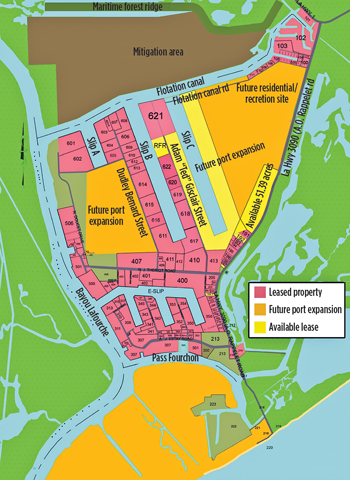 |
| Fig. 1. Map depicting the 2012 status of the northern expansion project. |
|
EXPANSION ON TARGET
As part of its aggressive northern expansion, the port recently completed 1,871 linear ft of bulkhead for Slip B, (Fig. 2), with 1,000 ft already leased to new tenant, Harvey Gulf International Marine, with another prospective tenant taking over the remaining 771 ft.
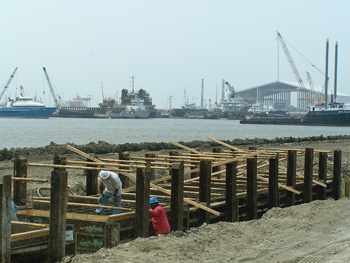 |
| Fig. 2. Work continues on the Slip B bulkhead. |
|
With Slip B nearing completion and Slip A finished, the port essentially is wrapping up the first phase of the expansion, all of which has been leased completely. Last fall, workers began the dredging process for the Slip C, (Fig. 3), Phase II development, which, when completed, Chiasson estimates will provide space for up to 10 single-lease tenants. By the end of this year, the commission intends to have completed an additional 1,800 ft of Slip C bulkhead. When all is said and done, the second phase of the northern expansion will have created more than 7,000 linear ft of slips totaling 15,000 ft of waterfront, most of which is committed.
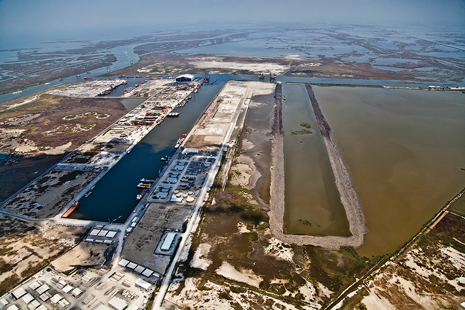 |
| Fig. 3. Port Fourchon’s Northern Expansion with new Slip C. |
|
“Everybody you talk to says 2012 is coming back with a vengeance. Things definitely are looking better, and that’s why we’re continuing to develop the port and prepare for the future,” said Chiasson.
The overall expansion and improvement program also extends to the adjoining South Lafourche Leonard Miller Jr. Airport, (Fig. 4), which, like Port Fourchon, falls under the jurisdiction of the Greater Lafourche Port Commission. The heavily utilized airport, which helps support deepwater operations, is in the process of completing a $4.5-million parallel taxiway, which, when finished, will clear the way for the installation of full-instrument landing systems. “This will allow us to attract more fixed-wing aircraft and give pilots the ability to come in under more inclement weather conditions. It opens up more business for the airport,” said Chiasson. The taxiway is being funded almost entirely by the U.S. Federal Aviation Administration (FAA), while the state has indicated that it would chip in for the instrumentation systems, once the taxiway is in place.
 |
| Fig. 4. A corporate jet departs the South Lafourche Leonard Miller Jr. Airport. |
|
Even though the expansion and improvement programs have remained on schedule, Chiasson said the port, like its tenants, was not immune from the dismal business climate that prevailed for most of 2010–2011, and responded accordingly. Beginning July 1, 2010, the port commission authorized a 30% reduction in basic land rental rates and froze annual escalation rates for one year, both of which resulted in a $3-million loss on the port books. The port returned to its normal rate structure on July 1, 2011.
“MIND BOGGLING” GROWTH
The now-12-year-old northern expansion project represents the latest chapter in a Cinderella-like story that opens with a largely inaccessible swamp of little import, other than to recreational fishing and hunting enthusiasts. This story evolves 52 years later into what even the U.S. government has decreed to be one of the most valuable pieces of real estate in the country. Located some 100 mi south of New Orleans, with its backyard nestled up to the deepwater Gulf of Mexico, Port Fourchon is the primary shore base for servicing more than 90% of all activities in deep and ultra-deep waters. This means that it effectively supports up to 18% of the nation’s oil and gas production. The state’s southernmost port also is home to the Louisiana Offshore Oil Port (LOOP) that offloads upwards of 1.2 million bpd of imported crude from some of the world’s largest supertankers.
Originally created by state decree in 1960 as a drop-off point for fruit and other South American imports, Port Fourchon came into being some 30 years before operators decided it might be a good idea to drill in the deeper waters of the Gulf of Mexico. Activity at the port began to accelerate with the 1995 passage of the federal Deep Water Royalty Relief Act that attracted a bevy of operators to the outer boundaries of the Gulf. Ten years later, weather got into the act with Hurricanes Katrina and Rita that slammed back-to-back into the Gulf of Mexico during the summer of 2005, severely damaging or wiping out the multiple supply bases along the coast.
In the wake of the twin storms, companies turned to Port Fourchon as the ideal location for consolidating their operations, spurring an expansion that has been nothing short of amazing. “From where Port Fourchon was back in 1997, it’s just mind-boggling how much it’s grown,” said Scott Wood, regional operations manager of Newpark Drilling Fluids.
As “The Gulf’s Energy Connection,” Port Fourchon boasts 130 tenants, but Chiasson emphasized that more than 250 companies actually operate directly out of the port or utilize it in some way. Many of those 130 tenants operate multiple leases, such as giant Edison Chouest Offshore, which is planning its own 71-acre lease that it holds at Slip B and Slip C.
As the port continues to make room for more tenants, those already in place say they are more than ready to return to the business that brought them there in the first place. None are more ready than Chiasson. He began his position in January 2010, replacing Ted Falgout, who until his retirement had served as the port’s first and only director. Three months later, Chiasson was thrown onto the national stage with the Deepwater Horizon tragedy and the oil spill that followed. Port Fourchon became the staging ground for personnel and equipment marshaled for the clean-up, and Chiasson was its spokesman.
REBOUND TAKING HOLD
“We recovered from the spill, and we’re recovering from the moratorium,” said Chiasson. “Business is picking up. We can see equipment being delivered, and drilling is taking place. Things definitely are moving in a positive direction. “The big issue now is the slow issuance and approval of permits, and new drilling plans. It’s been a slow-moving process.”
Although, as Chiasson said, the approval process for new wells remains mired in bureaucracy, rigs are returning to work and at a rate that seemed highly unlikely only a few months ago. As of March 9, according to Baker Hughes, 41 rigs were actively making hole in the Gulf of Mexico deep water and shelf, compared to 25 units drilling at the same time last year. With both industry and federal officials predicting that as many as 12 new deepwater rigs will enter the Gulf this year, it is becoming abundantly clear why the industry believes it has turned the corner and is headed in a positive direction.
One little-publicized issue that could throw a wrench into the buoyant forecast is a shortage of supply vessels large enough to support deepwater operations. The government shutdown prompted a well-publicized exodus of deepwater drilling rigs. However, receiving much less fanfare were the large-class service-and-supply vessels that accompanied them, also usually under long-term contracts. “The moratorium saw 70 large boats leave the Gulf, and now we’re starting to see a shortage,” said Pat Pitre, vice president of family-owned L & M Botruc Rental Co. of Galliano. His firm operates a fleet of 14 vessels, ranging from 180 to 240 ft in length. “It looks like 2012 is coming back strong, and we are close to being back to pre-Macondo utilization rates.”
Hornbeck Offshore Services Inc. hopes to take up the slack, announcing in November 2011 its intention to construct 16 “high-specification” offshore supply vessels as part of its latest newbuild program. Plans are for the major marine contractor to begin taking delivery in 2013.
Meanwhile, even though it is responsible for the slow permit approvals, the newly designated U.S. Bureau of Ocean Energy Management (BOEM) nonetheless has decided to offer new acreage for drilling this year. BOEM says that it will hold a Central Gulf of Mexico lease sale on June 20 that will cover roughly 38 million acres off Louisiana, Mississippi and Alabama.
While welcoming the Obama administration’s recognition of “the tremendous value of the Gulf energy industry in providing good jobs, tax revenue and energy security at a time when Americans need them most,” Lori LeBlanc, executive director of the grassroots Gulf Economic Survival Team (GEST), said it means little if not accompanied with timely approvals for drilling permits. GEST is heavily involved in lobbying federal officials to take the brakes off the issuance of drilling permits.
“Nearly a year-and-a-half after the lifting of the deepwater moratorium, there continues to be tremendous uncertainty with regard to the federal government’s ability to timely approve the necessary plans required to get the drill bits turning,” said LeBlanc in January, at the time the sale was announced.
Complementing the increased drilling activity are no less than six new deepwater floating production systems that are scheduled to deliver first oil over the next three years. One of these is slated for Chevron’s Jack/St. Milo project, which represents the operator’s first-ever production from the Lower Tertiary. Also among the soon-to-arrive new production systems are two tension leg platforms (TLPs)—Chevron’s Big Foot and Shell’s Olympus. The Anadarko Lucius and BP Mad Dog B floating production systems also are slated to be producing over the next two years.
“This is great for Portable Power because most of our activity is for production hook-up and commissioning,” said Ricky Adams, Broussard-based Southern Area Sales Manager for NOV Portable Power. “We’re also seeing more (drilling) permits being issued which is encouraging.”
AIR OF OPTIMISM, RELIEF
In gauging the mood of companies within and around Port Fourchon, it’s difficult to tell if they, indeed, are encouraged or relieved at finally taking leave of what by and large has been described as a miserable business climate. “This time last year, we had one job. You could sit here all day and never see a crane swinging,” said Newpark’s Scott. “It’s a lot better now. We’re not back to early 2008 yet, but we’re getting there.”
Others say that the industry has either returned or else is very close to matching the level of activity prior to Macondo. “We turned the curve in December, and things have really picked up. Now, we’re back to pre-Macondo levels,” said Tommy Fanguy, president of Houma, La.’s Supreme Service & Specialty Co., the largest independent specialty rental company.
“Last year, there were no boats or cranes moving, but now we should be at pre-Macondo levels by the end of 2012, and back to 2008 levels by 2013,” says Kurt Carpenter, vice president of sales for Delta Rigging & Tools. “We’re seeing it pick up in deep water. We’re bidding on 10,000-ft ropes, and we haven’t seen that in three years. We’re excited about the future.”
The sense that the climate is indeed brighter also extends to the largest, (Fig. 5), of the service companies operating out of Port Fourchon. “We’re not up to where we were pre-Macondo, but it’s starting to come back,” said Michael Moore, Halliburton’s Port Fourchon stock point manager. “Our cementing and frac guys are getting busy. The bottom line is, things are getting better.”
|
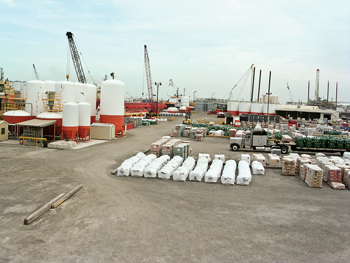
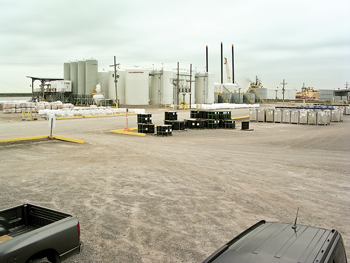
|
| Fig. 5. Liquid drilling fluid tanks tower over the M-I SWACO (top) and Halliburton (bottom) Port Fourchon facilities. |
|
Not surprisingly, business is especially strong these days for anything even remotely connected to environmental stewardship. “Anything that is closely regulated is moving better than others. For instance, our waste containment tanks are really going strong,” said Colby Crenshaw, team leader for Tiger Tanks of Houma. “We like the direction we’re headed in. It’s not great, but we’re seeing good trends.”
Mike Little, R360 Environmental Solutions’ vice president of operations for Region IV (Louisiana and Marine Operations), said the waste management firm is recovering after seeing its Port Fourchon business fall nearly 50% through most of 2010. That same year, R360 acquired local environmental firm US Liquids of Louisiana. “The new offshore regulations have not affected us directly by way of compliance, but they greatly reduced the number of drilling rigs in the Gulf of Mexico, which had a large impact on our business,” said Little. “It is starting to come back, and we are close to reaching our historical averages.”
Moreover, while Port Fourchon is universally known for its close link to the deep and ultra-deepwater market, it also serves as a service-and-supply center for the shelf, inland waters and even the arctic, as illustrated by Edison Chouest, which late last month delivered the newbuild M/V Aiviq icebreaker to Shell Exploration and Production, (Fig. 6). The 360-ft vessel will be used to support the operator’s Beaufort Sea exploratory drilling program, set to begin off Alaska this summer.
|
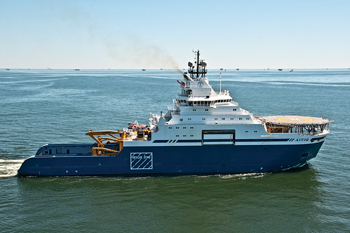
|
| Fig. 6. In late March, Galliano, La.-based Edison Chouest handed over the keys to the newbuild M/V Aiviq icebreaker to Shell Exploration and Production, which will use the 360-ft vessel in its planned arctic drilling program. Photo courtesy of Shell. |
|
Like the deepwater areas, those primarily involved with servicing jackups on the shelf say they also have seen a revival in drilling activity. This revival unfolded after New Orleans-based McMoRan Exploration Co. announced its 29,000-ft (TD) Davy Jones discovery in early 2010.
“Most people think Port Fourchon is just for deep water, but there’s a lot of drilling activity here on both the shelf and inland waters, which is our bread and butter. We’re a relatively small player in the deep water,” said Del Leggett, Newpark director of client relations. “The shelf is picking up. It’s definitely one of the bright spots.”
“I think the McMoRan deep pre-salt stuff will give new life to the shelf,” adds Dr. Joseph Orgeron, chief technology officer for Galliano’s Montco Offshore Inc., which operates a fleet of seven liftboats engaged primarily in plug-and-abandonment and decommissioning operations. “These discoveries are extending the life of the shelf.”
AIMING FOR THE FUTURE
As operators and service companies gear up to resume the business of drilling and producing, Chiasson said officials of Port Fourchon are looking beyond the immediate resurgence and what the industry of tomorrow will require. For instance, he said the port is in the process of gauging demand to determine whether to proceed with a fourth slip as part of a potential Phase 3 development. Whether or not the third phase reaches fruition, he said, the industry will need deeper drafts to accommodate the larger vessels that will be required, as operators continue to push the deepwater boundaries.
“As we look at the industry, we see clearly that it is going deeper and farther offshore, and operators will be using much larger vessels. We need to accommodate them,” he said. “While we’ve been focusing on the northern expansion, we’ve also been looking at what other opportunities there may be for the port.” 
|
LOCAL FIRMS REFILLING DRAINED PAYROLLS
The “Help Wanted” signs have returned to Port Fourchon. With offshore activity making what is considered a surprisingly fast comeback, companies are scurrying to fill positions that either were never filled or vacated by layoffs and transfers.
“Manpower may be a limiting factor. We couldn’t keep up with demand in 2008 because of personnel shortages,” said Kurt Carpenter, vice president of sales for Delta Rigging & Tools of Houma, La. As an executive of one of the nation’s foremost providers of specially trained personnel for the oil and gas sector, Paul Danos has a bird’s eye view of the altered employment market. He said that companies have been operating in, what he termed, a “steady state” with just enough employees to meet present requirements.
The comfortable situation reversed rapidly toward the end of 2011, with personnel shortages beginning to surface, especially for specialty disciplines like production operators, who possess a skill nearly impossible to transfer from other industries, added Danos. “We’ve seen a pronounced, significant demand over the past two months,” he said at the end of January. “It was like someone flipped a light switch.”
Elaborating further, Danos said the problem for companies operating on the shelf is that more employees are being lured to deepwater jobs, creating a domino effect. He said the shortage is particularly acute for production operators. “We’re getting non-stop calls from our customers, and folks we haven’t done business with recently, asking if we can help them find qualified production personnel.
As they are among the front line of those most affected when rigs return to work, service companies’ hiring practices can provide an indication of sorts of the current health of the industry. Both M-I SWACO and Newpark Drilling Fluids say that activity has turned sufficiently to allow them to replenish payrolls that had been sorely depleted.
With an estimated 100,000-bbl capacity of water, oil and synthetic-base drilling fluids, M-I SWACO is by far the largest such provider in Port Fourchon, (Fig. 5). But with drilling either non-existent or extremely sporadic, the company had no choice but to reduce staff either through transfers or furloughs. “We had 85 employees at the time of the moratorium, and then we were down by more than half, with most assigned elsewhere. We brought some of them back, and now we’re up to 60 and still hiring,” said Ron Domangue, senior warehouse manager of the company’s sprawling Port Fourchon facility.
Competitor Newpark says it is thankful to be re-building a staff that it was forced to cut severely in the face of a paucity of rigs needing mud. “At one point, we were down to 23 mud engineers, and we’re over 40 now,” said Regional Operations Manager Scott Wood. “A lot of the companies here are finally re-hiring, because everybody was so lean.” 
|
|









